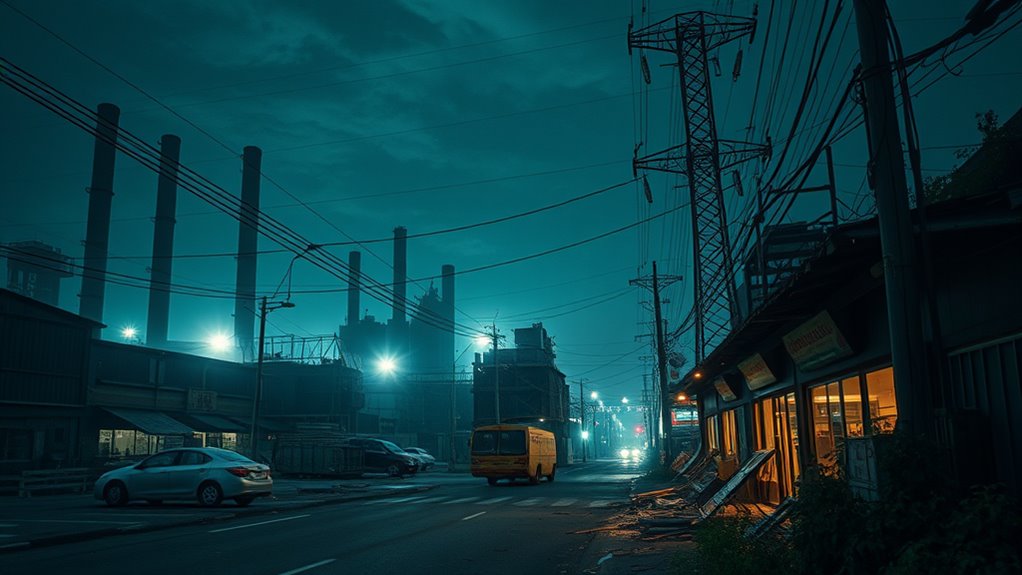If you imagine a world without electricity, chaos quickly unfolds. Healthcare collapses, as hospitals can't operate essential equipment, leading to increased mortality rates. Public services like water supply and emergency response fall apart, jeopardizing community safety. The economy takes a hit, causing losses estimated at $38 billion annually, while supply chains break down. Communication fails, isolating individuals and intensifying fears. Daily life suffers without consistent power, stifling social interactions and increasing mental health issues. It's an unsettling scenario that impacts every aspect of society. There's much more to explore about how this would transform our lives.
Essential Insights
- Healthcare systems would collapse, halting life-saving treatments and surgeries, increasing mortality rates from untreated conditions.
- Economic activity would suffer significantly, leading to an estimated annual loss of $38 billion due to power outages.
- Communication breakdowns would hinder information access, delaying emergency services and increasing the risk of civil disorder.
- Environmental consequences would arise from habitat destruction caused by renewable energy facilities, threatening biodiversity and ecosystems.
- Transportation challenges would intensify, resulting in increased greenhouse gas emissions and higher consumer prices due to disrupted supply chains.
Disruption of Public Services

Without electricity, public services would crumble, leaving communities vulnerable and chaotic. Imagine hospitals unable to operate essential equipment like ventilators or imaging machines. Life-saving treatments and surgeries would halt, directly impacting public safety. Medical records and patient data would become inaccessible, making it nearly impossible for healthcare providers to deliver informed care. Emergency services, including ambulances, would struggle to navigate and communicate effectively, further jeopardizing lives.
Transportation systems would also face significant challenges. Traffic signals and streetlights would fail, increasing the likelihood of accidents and gridlock. Public roadways would become chaotic, affecting personal and commercial transport. With railway systems halted and air traffic control compromised, the flow of people and goods would grind to a halt.
Water and sewage systems would be severely disrupted. Without powered water supply systems, you'd find yourself without access to clean water. Sewage treatment plants would cease operations, leading to serious environmental and health risks. Flood control systems would fail, heightening the danger of flooding in vulnerable areas. During high-risk weather conditions, the threat to these vital systems would increase, as a Public Safety Power Shutoff may become necessary to prevent further disasters.
The disruption of food and supply chains adds another layer of crisis. Refrigeration units would stop functioning, causing food spoilage. Supermarkets would struggle to maintain inventory, putting a strain on community resources. The inability to produce and distribute food and medicine effectively would challenge community response efforts, leaving many at risk.
In this world without electricity, the impact on public services would be profound, making it essential to understand the importance of reliable power in maintaining community safety and well-being.
Communication Breakdown

The collapse of public services leads to a staggering communication breakdown, compounding the chaos faced by communities. Without electricity, internet and phone lines become useless, eliminating quick access to information. You might find yourself relying on outdated methods to communicate and coordinate, which can greatly hinder emergency efforts.
Consider these challenges:
- Inaccessible data servers and email services halt information flow.
- Print media takes over as the primary news source, delaying important updates.
- Local broadcasting becomes essential, yet it's limited in reach and timeliness.
- Long-distance communication shifts to physical mail and word-of-mouth, introducing major delays.
- Emergency coordination falters, as military communication and public announcements struggle without electronic systems.
Prolonged outages could lead to civil disorder due to inability to access cash and conduct payments, highlighting the risk of a breakdown in essential services in such scenarios.
To navigate this breakdown, community networks become necessary. You can initiate contingency plans that incorporate low tech tools like two-way radios.
Establishing physical messengers within neighborhoods can facilitate information exchange and keep everyone informed.
Communities that prepare themselves with these strategies will maintain some level of connectivity, despite the chaos. By adopting a "high-tech, low-tech, no-tech" framework, you can guarantee that essential communications don't come to a complete standstill.
In this new reality, fostering collaboration and communication through alternative methods becomes critical for survival and resilience in the face of adversity.
Economic Collapse

Economic collapse can swiftly follow the breakdown of electricity, crippling communities and businesses alike. Power outages disrupt economic activity, leading to staggering losses. Firms across various sectors experience reduced utilization rates, costing the economy an estimated $38 billion annually. Sales losses due to electricity outages alone total $82 billion per year, while companies also incur costs for self-generated electricity, which can reach $64 billion annually.
This cycle of disruption hampers firms' ability to generate wealth and maintain competitiveness on a global scale. With unreliable infrastructure, businesses are forced to invest in costly backup power generators, driving up operational costs. These higher costs create barriers to entry for new and small firms, stifling innovation and limiting competition. Consequently, you see a decline in the job market, as job creation stalls and economic growth halts, particularly in less developed regions.
Without reliable power, countries struggle to lift their populations out of poverty and achieve higher income levels. Investment declines as firms divert funds from productive investments, such as new machinery, to cover operational costs. The opportunity costs are significant, stifling potential advancements and economic diversification. Additionally, the significant connection between energy consumption per capita and GDP per capita highlights how energy instability can exacerbate economic disparities.
When firms can't provide on-demand services due to unpredictable infrastructure, the overall economic output suffers. In the long run, increased power outages can reduce GDP per capita by nearly 2.9%. Without the backbone of reliable electricity, the economy falters, leaving communities vulnerable and holding back progress.
Healthcare Catastrophe

Access to healthcare drastically declines in a world without electricity. Imagine the chaos when medical emergencies arise, and clinics are forced to rely on candles or torches for lighting. Without reliable power, the following issues become critical:
- Life-saving operations can't take place after sunset, increasing patient risk.
- Vaccines lose effectiveness without proper refrigeration, leading to outbreaks of preventable diseases.
- Communication tools fail, making it impossible for healthcare providers to consult specialists or coordinate emergency transport.
- Poor lighting conditions lead to increased maternal and child mortality rates during nighttime procedures.
- Health facilities can't operate effectively, limiting the number of patients treated daily.
The lack of electricity compromises healthcare accessibility. Hospitals struggle to power essential diagnostic equipment like ultrasound and X-ray machines, delaying critical tests and treatments. Additionally, access to electricity is linked to significant improvements in child survival rates, which would be severely impacted without it.
You'd find it hard to trust that medications and blood samples are stored under safe conditions, risking their efficacy. Furthermore, the inability to communicate effectively during emergencies can lead to dire consequences, as healthcare professionals and patients alike are left in the dark—literally and figuratively.
Health facilities can't extend their hours, creating a bottleneck in patient care. The fire hazards from using candles pose additional risks, while the lack of clean water for hygiene drastically increases infection rates.
In a world without electricity, the healthcare system collapses, leaving countless lives hanging in the balance.
Supply Chain Disruptions

Healthcare's collapse isn't the only fallout from a world without electricity; supply chains would also face severe disruptions. Without power, automated systems and robotics that drive modern manufacturing would fail, leading to significant inefficiencies and downtime. Production schedules would be thrown off, causing delays and potential losses of essential products.
When power outages occur during data processing, there's a risk of data loss and corruption, further complicating operations. Warehouse operations would similarly grind to a halt. Automated storage and retrieval systems would become inoperative, impacting efficiency and order fulfillment.
You'd see inventory management become increasingly inaccurate, resulting in inventory mismanagement. With manual intervention required to handle orders and stock, labor costs would skyrocket. Logistics challenges would multiply.
Power fluctuations would diminish the reliability of supply chains, making it tough to maintain consistent delivery schedules. Without electronic devices, shipping and receiving would slow to a crawl. Communication disruptions, like phone and internet outages, would hamper coordination between suppliers and customers, exacerbating the situation.
As the reliability of your supply chain crumbles, you'd face financial consequences. Extended downtimes would lead to significant economic losses for businesses, while increased manual labor would further escalate operational costs. In a world without electricity, communication and technological advancements would also drastically decline, further complicating supply chain management.
Delays and inaccuracies in inventory management could result in financial penalties and loss of customer trust. In this world, the efficiency and trust in your supply chains would be severely compromised, threatening overall economic stability.
Social Isolation

In a world without electricity, social isolation becomes a harsh reality for many, especially the vulnerable. You may notice how the absence of communication tools impacts those who rely on them for connection. Consider the following:
- Elderly individuals struggle most without access to phones and internet.
- Vulnerable populations face heightened fears of robbery and physical assault.
- Isolation can worsen existing mental health issues like anxiety and depression.
- Community support networks break down, leaving individuals feeling alone.
- The overall sense of safety erodes, leading to increased stress.
As someone living in this bleak scenario, you'd likely feel the weight of loneliness. The elderly would struggle to connect with family or friends, amplifying their feelings of isolation.
Single people and families also share this fear, worrying about their safety in an environment where help is inaccessible.
Without electricity, you might find yourself anxious about basic needs—food, water, and hygiene. The stress of losing perishable items adds a layer of worry, while the inability to maintain personal hygiene could escalate your anxiety levels. The breakdown of communication can particularly contribute to feelings of isolation, as communication breakdowns lead to an increased sense of disconnection from the outside world.
It's not just about physical safety; it's about your mental health taking a hit during these trying times.
The closure of community centers and social services further deepens the void. With fewer opportunities to engage and support each other, the risk of long-term psychological effects like PTSD and depression rises.
In the end, social isolation in a powerless world is a silent but devastating crisis that many would face.
Impact on Daily Life

Without electricity, daily life quickly transforms into a struggle for survival and adaptation. Your kitchen becomes a challenge as refrigerators and freezers stop working, leading to food spoilage. You'll need to find cooking alternatives, relying on wood or coal stoves to prepare meals. The convenience of microwaves and electric ovens vanishes, forcing you to learn traditional cooking methods.
Household chores become labor-intensive. Washing machines and dishwashers are useless, so you'll wash clothes and dishes by hand, adding hours to your daily routine.
Lighting your home relies on candles and lanterns, reducing visibility and creating an atmosphere that feels foreign and dim.
Gone are the days of binge-watching your favorite shows or listening to music. The entertainment void leaves you searching for new ways to pass the time. Board games and storytelling might fill the gap, but the absence of electronic devices creates a stark shift in how you engage with family and friends.
In this world, healthcare also suffers. Crucial medical equipment becomes inoperable, making surgeries and emergency care extremely difficult. Without electricity, communication falters, impacting everything from routine check-ups to emergency services.
Transportation grinds to a halt as public transit systems fail, and traffic lights cease to function, resulting in chaos on the roads.
Environmental Consequences

Life without electricity not only disrupts your daily routines but also has far-reaching environmental consequences. The reliance on renewable energy sources, while beneficial in some ways, can lead to significant habitat fragmentation and ecosystem stress. You may not realize it, but the construction and maintenance of these facilities can seriously impact the natural world around you.
Consider the following effects:
- Habitat destruction displaces local wildlife.
- Wind turbines pose risks to birds and bats.
- Solar installations disrupt native plant and animal habitats.
- Power lines and access roads fragment natural landscapes.
- Ecosystem balance is altered, threatening biodiversity.
When you think about renewable energy, it's easy to overlook the hidden costs. The placement of these facilities can stress animal populations and disrupt their migration patterns. For example, when power lines cut through forests or wetlands, they disturb habitats and put additional pressure on already struggling species.
Vegetation control around these installations often uses herbicides, which can harm local flora.
Moreover, while renewable energy aims to reduce greenhouse gas emissions, the overall health of ecosystems can still be compromised. Endangered species, unable to relocate, face threats that can lead to extinction.
Changes in Transportation

As society shifts to a world devoid of electricity, transportation systems face dramatic changes that ripple through urban and rural areas alike. Public transportation, once efficient and eco-friendly, would now rely heavily on diesel and gasoline-powered buses and trains. This shift leads to increased emissions and air pollution, particularly in cities where air quality already poses health risks.
Connectivity between villages, towns, and cities would suffer, exacerbating economic and social isolation, while the efficiency and capacity of these systems plummet. You'd find yourself relying more on internal combustion engine vehicles, leading to a surge in demand for fossil fuels. Traffic congestion would worsen as incentives for electric vehicles vanish, further complicating your daily commute.
The increased greenhouse gas emissions and local pollutants would create mobility challenges that affect everyone. Freight transportation would revert to traditional fuel-based trucks, considerably raising carbon emissions and operational costs for logistics companies. As a result, the sustainability of goods transportation would take a hit, pushing you to grapple with higher prices at stores.
Moreover, transportation innovation would stall. Emerging technologies like the Hyperloop and electric bikes would be shelved indefinitely. Without electricity, you wouldn't see autonomous buses or other advancements in public transport, and even alternative power sources for systems like cable cars would remain out of reach.
This new reality would reshape how you navigate your world and interact with your community, leaving you to contend with the challenges of transportation in a less connected, more polluted environment.
Resilience and Adaptation Strategies

In a world stripped of electricity, you must adapt and embrace innovative resilience strategies to navigate daily challenges. Here are some key approaches you can consider:
- Decentralized energy solutions to empower local communities.
- Renewable investments to harness solar and wind resources effectively.
- Backup systems to guarantee a reliable energy supply during outages.
- Innovative technologies that improve energy efficiency and accessibility.
- Financial initiatives to support sustainable energy projects in underserved areas.
Transitioning to decentralized energy can provide greater flexibility, especially in rural regions. By deploying solar mini grids and home systems, you can secure access to electricity even when the central grid fails.
Additionally, investing in renewable energy sources is vital. These resources not only help in addressing energy access but also mitigate the environmental impact of traditional energy sources.
Implementing backup systems, like generators, while costly, can be a short-term solution for critical needs. However, the focus should remain on innovative technologies that enhance energy efficiency and reliability.
Financial initiatives are important to support research and development, guaranteeing that new solutions are both accessible and sustainable.
As you consider these strategies, remember that collaboration with global entities, like the World Bank, can amplify your efforts. By prioritizing resilience and adaptation, you can navigate the complexities of a world without electricity while fostering a sustainable future.
Frequently Asked Questions
How Would Education Systems Adapt Without Electricity?
Without electricity, education systems would transform into bustling hubs of creativity and collaboration.
You'd immerse yourself in alternative teaching methods, relying on manual learning and resource sharing among students and teachers. Community collaboration would thrive, fostering experiential education opportunities that ignite creative expression.
Instead of screens, you'd explore hands-on projects and discussions, where ideas flow freely.
Though challenging, this shift could lead to innovative solutions, making learning a vibrant, collective experience.
What Would Happen to Entertainment and Leisure Activities?
Without digital entertainment, you'd find joy in live performances and storytelling sessions, gathering around with friends and family.
Outdoor games would become a daily delight, while reading clubs and board games would foster connections.
You'd cherish social gatherings and community events, sharing laughs and creating memories.
Traditional crafts would flourish, as people embrace hands-on creativity.
The absence of screens would lead to deeper bonds and a resurgence of timeless pastimes that bring everyone together.
How Would Agriculture Be Affected in a Non-Electric World?
Without electricity, agriculture would revert to traditional farming methods, drastically affecting productivity.
Did you know that modern machinery can increase crop yields by up to 300%?
In a non-electric world, you'd rely on manual irrigation and labor-intensive techniques for planting and harvesting.
Precision agriculture would be impossible, and maintaining controlled environments for crops and livestock would vanish.
This shift would reduce efficiency and make sustainable practices much harder to achieve.
What Would Be the Impact on Law Enforcement and Security?
In a world without electricity, your ability to maintain law enforcement and security would be severely compromised.
Crime prevention efforts would falter as surveillance systems fail, leaving you with limited means to monitor public spaces.
Communication breakdowns would hinder coordination, making response times slower.
You'd have to rely on community support and traditional methods to guarantee safety, but the risk of crime and civil unrest would likely increase, challenging your role in maintaining order.
How Would Cultural Preservation Efforts Change Without Digital Resources?
Without digital resources, cultural preservation efforts would shift to traditional methods.
You'd see communities relying more on physical archives and local expertise, which might limit access to broader audiences.
Community involvement would become essential, as local groups would gather to document and preserve heritage manually.
While this fosters stronger bonds within communities, it could also hinder the reach and efficiency of preservation initiatives, making it harder to safeguard cultural treasures for future generations.
